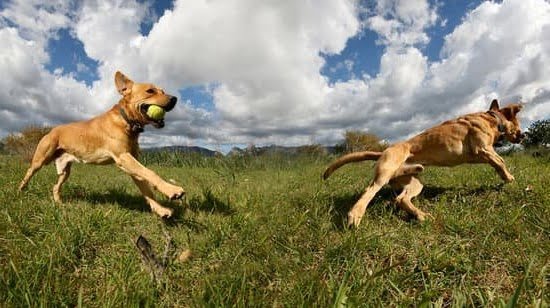Dogs chewing their beds can be a frustrating and destructive behavior for any pet owner. It not only destroys expensive bedding but also poses a potential health risk to the dog. Understanding why dogs engage in this behavior is crucial in finding effective solutions to stop it. In this article, we will explore the various factors that contribute to bed chewing, as well as provide practical training techniques and preventative measures.
Chewing is a natural behavior for dogs, especially puppies who are teething or exploring their environment. However, when this behavior extends to their bed, it can become problematic. Dogs may chew their beds due to boredom, anxiety, or teething discomfort. By understanding the root cause of this destructive behavior, pet owners can implement appropriate strategies to redirect their dog’s attention towards more acceptable outlets.
Establishing boundaries and reinforcing positive behavior are essential steps in training a dog not to chew his bed. Dogs thrive on structure and consistency, so setting clear rules and consistently enforcing them is crucial. Creating a safe and engaging environment for your dog can help reduce the likelihood of them resorting to destructive behaviors like bed chewing.
In the following sections of this article, we will delve deeper into these topics and provide practical tips for preventing bed chewing through diversion techniques, positive reinforcement training methods, and the use of bitter apple spray and anti-chew products. We will also explore how separation anxiety can contribute to bed chewing and suggest coping strategies for both dogs and owners alike.
By following these guidelines and consulting with professionals if needed, pet owners can successfully train their dogs not to chew their beds. Patience, consistency, and understanding are key in cultivating a healthy environment where dogs can thrive without resorting to destructive habits. So let’s dive into the various aspects of training a dog not to chew his bed.
The Importance of Establishing Boundaries and Reinforcing Positive Behavior
Establishing boundaries and reinforcing positive behavior are essential steps in training a dog not to chew his bed. Dogs, like any other pet, need clear guidelines and structure to understand what is expected of them. This section will discuss why boundaries and positive reinforcement are important in preventing destructive chewing behavior.
Setting clear boundaries means establishing rules and limitations for your dog. This helps them understand what is acceptable behavior and what is not. By consistently enforcing these boundaries, you can prevent your dog from developing destructive habits such as chewing on his bed. It’s important to be consistent with the rules you set, as inconsistency can confuse your dog and make it harder for them to learn.
Reinforcing positive behavior is another crucial aspect of training a dog not to chew his bed. Instead of focusing on punishment for unwanted behavior, it is more effective to reward and reinforce good behavior. When your dog refrains from chewing his bed or chooses an appropriate toy instead, praise him and give him a treat or verbal affirmation. This positive reinforcement teaches your dog that making the right choices leads to rewards, encouraging him to continue exhibiting those behaviors.
In addition to setting boundaries and reinforcing positive behavior, it’s also important to provide alternative outlets for your dog’s chewing needs. Dogs naturally have a desire to chew, especially during certain stages like teething or when they are bored or anxious. By providing appropriate chew toys or bones, you can redirect their chewing behavior onto more suitable objects. Ensuring that your dog has plenty of mental and physical stimulation will also help reduce boredom-induced chewing.
Overall, establishing boundaries and reinforcing positive behavior are fundamental in training a dog not to chew his bed. Consistency and patience are key when implementing these strategies. By providing clear guidelines, rewarding good behavior, redirecting their attention, and offering appropriate chew toys, you can ultimately prevent destructive chewing habits in your canine companion.
| Importance of Establishing Boundaries and Reinforcing Positive Behavior |
|---|
| Setting clear boundaries for your dog helps them understand what is acceptable behavior and what is not. |
| Consistently enforcing these boundaries can prevent destructive chewing habits. |
| Reinforcing positive behavior encourages dogs to make the right choices by rewarding them. |
Identifying the Root Cause
One of the key steps in training a dog not to chew his bed is identifying the root cause behind this destructive behavior. Dogs may chew their beds due to different reasons such as boredom, anxiety, or teething. Understanding the underlying cause will help you implement effective training strategies and provide appropriate solutions for your furry friend.
Boredom can be a significant factor contributing to bed chewing. Dogs are naturally active animals and need mental and physical stimulation to prevent boredom. If they do not have enough activities or toys to engage with, they may resort to chewing on their bed out of sheer boredom. It is important to ensure that your dog’s environment is enriched with plenty of toys, interactive puzzles, and regular exercise routines to keep them mentally stimulated and physically tired.
Anxiety is another common cause of bed chewing in dogs. Separation anxiety, in particular, can lead dogs to engage in destructive behaviors such as chewing on objects, including their own beds.
Dogs with separation anxiety feel distressed when left alone and resort to destructive behaviors as a means of coping with their anxiety. If your dog shows signs of anxiety when you leave the house or displays clingy behavior whenever you’re present, it is crucial to address the underlying anxiety issue through counter-conditioning techniques, gradual desensitization exercises, and providing comfort through comforting scents or soothing music.
Teething can also be responsible for bed chewing in puppies. Just like human babies, puppies go through a teething process where their baby teeth fall out and are replaced by permanent adult teeth.
During this time, they experience discomfort and an irresistible urge to chew as a way of relieving pain or itching in their gums. To prevent your puppy from targeting his bed during this stage, make sure he has access to appropriate teething toys such as rubber chew toys or specially designed teething rings that can soothe his gums and satisfy the chewing urge.
By identifying whether boredom, anxiety, or teething is the root cause behind your dog’s bed-chewing behavior, you can tailor your training approach to address the specific issue at hand. Whether it involves providing more mental and physical stimulation, implementing anxiety-reducing techniques, or offering appropriate teething toys, a targeted strategy will help deter bed chewing and encourage positive behavior in your furry companion.
Creating a Safe and Engaging Environment for Your Dog
Creating a safe and engaging environment for your dog is crucial in preventing bed chewing behavior. When dogs are bored or anxious, they often resort to destructive behaviors like chewing on their bed. By providing them with an environment that meets their physical and mental needs, you can effectively redirect their energy and reduce the likelihood of bed chewing.
Firstly, it’s important to ensure that your dog has plenty of toys and activities to keep them occupied. Interactive toys, puzzle toys, and treat-dispensing toys are great options to engage your dog’s mind and prevent boredom. Rotate these toys regularly to keep things interesting for your dog.
In addition to toys, regular exercise is essential for dogs. A tired dog is less likely to engage in destructive behaviors out of boredom or excess energy. Set aside dedicated time each day for exercise such as walks, runs, or playtime at the park. This physical activity not only keeps them physically fit but also helps with mental stimulation.
Another aspect of creating a safe environment involves puppy-proofing your home. Remove any potential hazards such as electrical cords or poisonous plants that can tempt your dog to chew on them. Keep items like shoes, socks, and other personal belongings out of reach to prevent your dog from associating these objects with chewing.
Lastly, providing a comfortable resting area for your dog can help deter bed chewing behavior. Choose a durable and chew-resistant bed made from materials that are difficult to destroy. Consider using bedding specifically designed for dogs who have a tendency to chew or opt for crate training until the destructive behavior subsides.
By creating an environment that stimulates both the mind and body of your pup while limiting access to forbidden items, you can greatly reduce the chances of bed chewing behavior occurring.
| Aspect | Recommendations |
|---|---|
| Provide Toys | Interactive toys, puzzle toys, treat-dispensing toys |
| Regular Exercise | Dedicated time for walks, runs, playtime at the park |
| Puppy-Proofing | Remove potential hazards, keep personal belongings out of reach |
| Comfortable Resting Area | Durable and chew-resistant bed, crate training if needed |
Effective Training Techniques
Training a dog not to chew his bed can be a challenging task, but there are several effective techniques that can help redirect their attention and prevent this destructive behavior. One technique is to provide an alternative chew toy or bone that is more appealing to the dog. Introducing interactive toys, such as puzzle toys or treat-dispensing toys, can also keep them engaged and focused on something other than their bed.
Another effective training technique is redirection. Whenever you catch your dog chewing on his bed, calmly say “no” and redirect his attention to an appropriate chew toy or bone. It’s important to catch them in the act so they associate the correction with their behavior at that moment. Consistency is key when using redirection as a training method, so be sure to consistently reinforce appropriate chewing behavior by providing the alternative chew items.
Additionally, creating a structured routine for your dog can help prevent bed chewing. Dogs often engage in destructive behaviors out of boredom or lack of physical and mental stimulation. Make sure your dog receives enough exercise and playtime each day, as a tired dog is less likely to engage in destructive behaviors. Establishing regular feeding times and incorporating obedience training sessions into their daily routine can also keep their mind stimulated and reduce the desire to chew on their bed.
Remember, it’s important to be patient and consistent when training your dog not to chew his bed. It may take time for them to learn the appropriate behavior, so continue reinforcing positive chewing habits through diversion and redirection. By providing engaging alternatives and establishing a structured environment for your dog, you can effectively train them away from this destructive habit.
Harnessing the Power of Positive Reinforcement
Positive reinforcement is a powerful tool when it comes to training dogs not to chew their beds. By associating desirable behaviors with rewards, you can motivate your dog to change his chewing habits and reinforce positive behavior effectively. In this section, we will explore the techniques and strategies involved in reward-based training.
Choosing the Right Rewards
When using positive reinforcement, it’s important to choose rewards that are highly motivating for your dog. Every dog is different, so it’s essential to find what your furry friend finds most rewarding. For some dogs, treats may be the ultimate prize, while others may be more motivated by praise or playtime with a favorite toy. Experiment with different rewards to determine what works best for your dog.
Timing and Consistency
Timing is crucial when utilizing positive reinforcement as a training method. The reward should be given immediately after your dog displays the desired behavior, so he can make a clear association between the action and the reward. Consistency is also vital; ensure that you reward your dog every time he behaves appropriately and refrains from chewing his bed.
Clicker Training
Clicker training can be an effective way to teach a dog not to chew his bed using positive reinforcement. This method involves pairing the sound of a clicker with a treat or reward each time your dog refrains from chewing or redirects his attention elsewhere. Over time, your pet will associate the clicker noise with receiving a reward and will learn to stop chewing his bed upon hearing it.
Shaping Behavior
Another technique in reward-based training is shaping behavior. Rather than waiting for your dog to completely stop chewing his bed, you can gradually shape his behavior by reinforcing small steps towards the desired goal. For example, if your dog starts sniffing or moving away from his bed without engaging in destructive chewing, provide immediate praise or a reward. This will help him learn that moving away from the bed is the desired behavior, gradually reducing his chewing tendencies.
By harnessing the power of positive reinforcement and incorporating reward-based training techniques into your dog’s routine, you can effectively train him not to chew his bed. Remember to select appropriate rewards, be consistent with timing and reward delivery, consider using clicker training, and shape your dog’s behavior through small steps towards the desired goal. With patience and consistency, you’ll see significant progress in reducing your dog’s destructive chewing habits.
Prevention is Key
When it comes to training a dog not to chew his bed, prevention is often the most effective strategy. One way to prevent this destructive behavior is by using bitter apple spray or other anti-chew products. Bitter apple spray is a safe and non-toxic substance that can be applied to your dog’s bed or other items they may be tempted to chew on.
What is Bitter Apple Spray?
Bitter apple spray is a deterrent that has a strong and unpleasant taste, making it unappealing for dogs. Most bitter apple sprays are made from natural ingredients such as water, isopropyl alcohol, and bittering agents like grapefruit extract. The foul taste discourages dogs from chewing on sprayed surfaces.
How to Use Bitter Apple Spray
To use bitter apple spray effectively, start by thoroughly cleaning your dog’s bed or any other item you want to protect from being chewed. Then, generously apply the spray onto the surface of the bed or object. Be sure to follow the instructions provided by the manufacturer for best results.
It’s important to note that while bitter apple spray can be very effective, some dogs may still be determined enough to persist in chewing despite the unpleasant taste. In such cases, it may be necessary to combine this strategy with other training techniques for maximum effectiveness.
Other Anti-Chew Products
In addition to bitter apple spray, there are several other types of anti-chew products available on the market. These include chew deterrent sprays with different tastes like citrus or vinegar, chewing deterrent gels, and even specially designed anti-chew furniture covers or mats.
When choosing an anti-chew product, consider your dog’s individual preferences and needs. Some dogs may respond better to certain scents or textures than others. Experimenting with different products and observing your dog’s reaction can help you determine the most effective solution for preventing bed chewing.
By using bitter apple spray or other anti-chew products, you can protect your dog’s bed and other items from being destroyed. However, it is important to combine this prevention strategy with consistent training techniques to address the root cause of your dog’s chewing behavior. Remember, prevention is key, but understanding and addressing the underlying reasons for your dog’s behavior will be essential to long-term success in stopping bed chewing.
Addressing Separation Anxiety
Separation anxiety is a common issue that can lead to destructive behaviors such as bed chewing in dogs. When left alone, dogs with separation anxiety may experience extreme stress and anxiety, causing them to engage in destructive behaviors as a way to cope with their emotions. Fortunately, there are several coping strategies that can help reduce bed chewing and alleviate separation anxiety in dogs.
One effective strategy for addressing separation anxiety is gradual desensitization. This involves gradually getting your dog used to being alone for longer periods of time. Start by leaving your dog alone for just a few minutes and gradually increase the duration over time. During these practice sessions, it’s important to create a positive environment by providing your dog with engaging toys and treats that will keep them occupied while you’re away.
Another coping strategy is counter-conditioning, which involves changing your dog’s emotional response to being alone. This can be done by associating your departure with something positive, such as special toys or treats that your dog only gets when you’re away. By creating positive associations with being alone, your dog will start to see it as a pleasant experience rather than something stressful.
Additionally, providing mental stimulation and physical exercise before leaving can help reduce separation anxiety. Taking your dog for a long walk or engaging them in interactive play sessions before you leave can help tire them out and release any pent-up energy they may have. Mental stimulation activities like puzzle toys or treat-dispensing toys can also keep their minds occupied while you’re gone.
Consulting with a Professional Dog Trainer or Behaviorist
Consulting with a professional dog trainer or behaviorist can be extremely beneficial when dealing with a dog that chews his bed. These professionals have the expertise and experience to assess the root cause of the behavior and provide tailored solutions to address it effectively. Here are some reasons why consulting with a professional should be considered:
- Expert Guidance and Assessment: A professional dog trainer or behaviorist can accurately assess your dog’s behavior, identify any underlying issues, and determine the most appropriate training methods to address the bed chewing problem. They understand canine behavior and can create a customized training plan specifically designed for your dog’s needs.
- Effective Training Techniques: Professional trainers have an arsenal of effective training techniques that they can employ to modify your dog’s behavior. They will guide you on how to redirect your dog’s chewing tendencies onto appropriate toys or chew bones, teaching him what is allowed and what is not.
- Behavior Modification Strategies: In some cases, bed chewing may be a symptom of a deeper behavioral issue such as anxiety or fear. A professional behaviorist can help identify and address these underlying issues through various behavior modification strategies, helping your dog overcome his destructive behavior.
When consulting with a professional, it is important to choose someone who uses positive reinforcement techniques rather than harsh punishments or aversive methods. Positive reinforcement focuses on rewarding desired behaviors while ignoring unwanted behaviors, ensuring a more positive and effective learning experience for your furry friend.
Overall, reaching out to a professional dog trainer or behaviorist should be considered if you are struggling to train your dog not to chew his bed. Their expertise and guidance can make all the difference in successfully modifying your dog’s behavior and creating a happy and peaceful living environment for both you and your four-legged companion.
Conclusion
In conclusion, training a dog not to chew his bed requires patience, consistency, and understanding. It is important to understand why dogs engage in this destructive behavior, whether it is due to boredom, anxiety, or teething. By identifying the root cause and creating a safe and engaging environment for your dog, you can help prevent bed chewing.
Effective training techniques such as diverting attention and redirection can be used to teach your dog what is acceptable to chew on. Harnessing the power of positive reinforcement through reward-based training will encourage your dog to engage in desirable behaviors instead of destructive ones.
Prevention also plays a crucial role in preventing bed chewing. By using products like bitter apple spray or anti-chew products, you can deter your dog from chewing on his bed. Additionally, addressing separation anxiety with coping strategies can help reduce bed chewing behavior.
If you find that despite your efforts the problem persists, it may be beneficial to consult with a professional dog trainer or behaviorist. They have the expertise and experience necessary to assess the situation and provide tailored guidance for addressing the issue.
Ultimately, training a dog not to chew his bed requires time and consistency. With patience and understanding, coupled with effective training techniques and preventive measures, you can successfully achieve a bed-chewing-free dog. Remember to celebrate small victories along the way and continue reinforcing positive behaviors as they arise.
Frequently Asked Questions
How do I stop my dog from destroying his bed?
To stop your dog from destroying his bed, it is important to identify the underlying cause of this behavior. Dogs may destroy their beds due to boredom, anxiety, frustration, or even discomfort. If you suspect discomfort, a visit to the veterinarian can help determine if there are any underlying health issues.
Once you have ruled out medical reasons, providing your dog with enough mental and physical stimulation can make a significant difference. Ensuring regular exercise and playtime can help tire out your dog, reducing the urge to engage in destructive behavior. Additionally, offering alternative chewing options such as durable chew toys can redirect your dog’s attention away from his bed.
How do I stop my dog from chewing on furniture when left alone?
When it comes to preventing your dog from chewing on furniture when left alone, it is vital to create a safe and stimulating environment for them. Begin by puppy-proofing the house and removing any items that may be enticing for your dog to chew on while you are away. A crate or designated area can be useful in preventing access to furniture altogether when unsupervised.
Providing appropriate chew toys will give your dog an acceptable outlet for their chewing instincts while keeping them entertained. Using positive reinforcement techniques such as rewards and praise whenever they choose the appropriate chew toy will reinforce desired behavior.
How do I train my dog not to chew on everything?
Training your dog not to chew on everything requires patience and consistency but is achievable with proper guidance. Start by ensuring that your dog has plenty of chew toys specifically designed for this purpose. Whenever you catch them attempting to chew on something inappropriate, redirect their attention towards an appropriate toy and reward them for choosing it instead.
Consistently reinforcing this behavior over time will help them understand the distinction between what they can and cannot chew on. Utilizing deterrents such as bitter sprays or pet-safe tastes on objects that should not be chewed can also help deter dogs from undesirable chewing habits. It is crucial to remain consistent with training and provide ample positive reinforcement to ensure long-term success in curbing their chewing tendencies.

Welcome to the blog! I am a professional dog trainer and have been working with dogs for many years. In this blog, I will be discussing various topics related to dog training, including tips, tricks, and advice. I hope you find this information helpful and informative. Thanks for reading!





